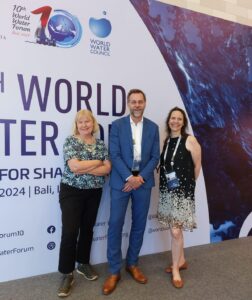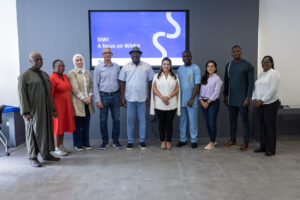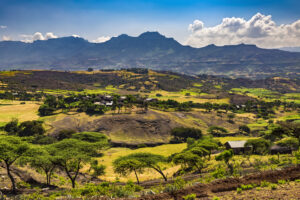What is the role of water in rural and urban school facilities?
The presence or absence of water in rural and urban landscapes is very much dependent on the hydrological cycle. Erratic rainfalls caused by climate change can create too much or too little water for communities, affecting the availability of clean and safe water for drinking, sanitation and hygiene.
As a WASH expert, Henning Göransson Sandberg explains here how the increasing effects of climate change require stronger cooperation between Water Resource Management and WASH to ensure better access to education for all.
What comes to mind first, when speaking of water in rural and urban landscapes, and why?
My work is focused on water, sanitation and hygiene services, so for me, I think of how we can ensure the human right to clean drinking water, safe sanitation and hygiene to preserve human dignity and health.
For a long time, the water sector has made the distinction between water resources more broadly, focusing on ensuring the long-term sustainability and availability of water resources for various uses, and more specifically on water, sanitation and hygiene (WASH), which focuses on human consumption of water at the household and community levels.
While they are interrelated and dependent on each other for their objectives, the sectors have historically worked relatively separately. For example, within SIWI, the WASH and Water Resource Management (WRM) departments have worked as separate departments. However, with the effects of climate change being increasingly felt, essentially through too little, too much water or too polluted water, this distinction becomes less useful, and the need for cooperation between these two areas becomes more important. SIWI has recently published a report which proposes a framework that can be used to improve cooperation between WRM and WASH, illustrated with examples and case studies.
My current focus has been specifically on the impact of climate change related risks on WASH services in schools. While vulnerable to the same risks, such as water scarcity for drinking and hygiene, and infrastructure damage in schools and education facilities, communities face unique challenges which are caused by, or exacerbated by, climate risks.
“While vulnerable to the same risks, such as water scarcity for drinking and hygiene, and infrastructure damage in schools and education facilities, communities face unique challenges which are caused by, or exacerbated by, climate risks.”
What are the key climate risks faced by schools?
One of the key risks faced by schools includes damage to WASH infrastructure, resulting in non-functionality. Infrastructure can be damaged by heavy floods or salinity corroding pipes. Often schools may not have sufficient resources to repair infrastructure, and technical support may not always be readily available or cost-effective. Climate risks may also overwhelm waste management systems, resulting in overflow, spreading of waste and pollution. A lack of clean and safe WASH facilities, including facilities for hygiene, may result in poor health and the spread of water- and vector-borne diseases.
Damaged or broken WASH facilities due to climate risks may lead to school closures or school dropouts, particularly for girls, if menstrual hygiene management facilities are not in place. A 2022 study in the Gambia found that girls who were menstruating reported that when clean toilets, soap, and school latrines were available, the risk of school absenteeism was reduced. School absenteeism has negative effects on education levels in the short term, income, health outcomes and can lead to an increase in child marriages and teen pregnancies in the long run. For example, a Save the Children report from Uganda saw large increases in teenage pregnancies and child marriages as a result of school closures due to the COVID-19 pandemic. Although this was not linked to a climate risk, it shows the importance of keeping schools open during climate risk events and ensuring that WASH facilities are functional.
Schools are also often the focus of the community, in several ways. Firstly, they are important communication and information points. Information can be communicated to the community, and school children can act as agents of change by spreading knowledge they have gained about good WASH practices to their households. Social norms can be both a a powerful barrier to good WASH practices, and also a powerful tool for children and adults to adopt good practices and demand their human right to WASH. Secondly, schools are sometimes home to water points, or sanitation facilities, used by the community as a whole. While this may not be desirable, as schools should have their own private water supply and sanitation facilities, in the event that other facilities fail, these may become essential for the community. Additionally, schools may also be used as evacuation centers or temporary shelters, either by design or by necessity, in case of conflict or during severe climate events, making the need for functional and adequate facilities increasingly important.
What are some of the obvious and some of the more complex solutions?
We need solutions at all levels to ensure adequate WASH services in schools. These should range from simple, cost-effective, practical solutions that each school can implement with their existing resources, to the more complex governance solutions that ensure resilient and sustainable service delivery.
The simple cost-effective solutions should include making certain that schools conduct their own climate risks assessments before planning, building or upgrading their water points or toilets to ensure that they take into account and adapt to any risks they might face. These might include areas more prone to flooding or ensuring that wells are functional even in a drought.
I wanted to highlight another simple but powerful solution which came to my attention during the Stockholm Junior Water Prize in 2022. This is a competition for students and young people aged 15 to 20 who have developed school projects that can solve major water challenges. The innovative ideas, resilience, and brilliance of the young people taking part always blows my mind. The specific example that comes to mind is the project by Unam Halam and Faith Claasen from South Africa, who developed The Drop Saver, which would help their school, Heatherlands High, reduce water waste, conserve water, and save on water bills. This is especially important in Western Cape.In 2018, Cape Town experienced the worst recorded drought inits history, coming close to running out of water completely and being only days away from reaching “Day Zero”.
Part of the project was to invent a device that could be easily and cheaply fashioned from readily available material from local supply shops, which could be attached to the tap, stopping the running of water when the tap was not in use, as well as keeping it from leaking. The Drop Saver was estimated to save 1300 liters of water per month with just one device installed, and many times its installation cost, it also helped create awareness amongst the students of how important it is to save precious water resources.
On the other hand, we also need improvements to the enabling environment to ensure climate resilient WASH facilities, which need to be agreed and implemented at the national, provincial, or municipal level. This ranges from the right policies and strategies considering the climate risks faced by the different parts of the country, to improved knowledge and capacities related to climate risks and adaptation strategies. This includes ensuring that the correct standards exist for climate resilient infrastructure, that those standards are followed, and that adequate financing exists for the installation and day-to-day operations and management of this infrastructure.
Adapting to climate risks that can disrupt education is crucial. Education is one of the best tools for ending poverty. As highlighted by UNESCO in a 2017 report, if all students in low-income countries had just basic reading skills (nothing else), an estimated 171 million people could escape extreme poverty. If all adults completed secondary education, we could cut the global poverty rate by more than half. Thus, ensuring that schools can remain open when climate risks, or other risks, happen is imperative, with clean drinking water, safe sanitation, and following adequate hygiene protocols being a key part.
“We need solutions at all levels to ensure adequate WASH services in schools. These should range from simple, cost-effective, practical solutions that each school can implement with their existing resources, to the more complex governance solutions that ensure resilient and sustainable service delivery.”
I wanted to highlight another simple but powerful solution which came to my attention during the Stockholm Junior Water Prize in 2022. This is a competition for students and young people aged 15 to 20 who have developed school projects that can solve major water challenges. The innovative ideas, resilience, and brilliance of the young people taking part always blows my mind. The specific example that comes to mind is the project by Unam Halam and Faith Claasen from South Africa, who developed The Drop Saver, which would help their school, Heatherlands High, reduce water waste, conserve water, and save on water bills. This is especially important in Western Cape. In 2018, Cape Town experienced the worst recorded drought inits history, coming close to running out of water completely and being only days away from reaching “Day Zero”.
Part of the project was to invent a device that could be easily and cheaply fashioned from readily available material from local supply shops, which could be attached to the tap, stopping the running of water when the tap was not in use, as well as keeping it from leaking. The Drop Saver was estimated to save 1300 liters of water per month with just one device installed, and many times its installation cost, it also helped create awareness amongst the students of how important it is to save precious water resources.
On the other hand, we also need improvements to the enabling environment to ensure climate resilient WASH facilities, which need to be agreed and implemented at the national, provincial, or municipal level. This ranges from the right policies and strategies considering the climate risks faced by the different parts of the country, to improved knowledge and capacities related to climate risks and adaptation strategies. This includes ensuring that the correct standards exist for climate resilient infrastructure, that those standards are followed, and that adequate financing exists for the installation and day-to-day operations and management of this infrastructure.
Adapting to climate risks that can disrupt education is crucial. Education is one of the best tools for ending poverty. As highlighted by UNESCO in a 2017 report, if all students in low-income countries had just basic reading skills (nothing else), an estimated 171 million people could escape extreme poverty. If all adults completed secondary education, we could cut the global poverty rate by more than half. Thus, ensuring that schools can remain open when climate risks, or other risks, happen is imperative, with clean drinking water, safe sanitation, and following adequate hygiene protocols being a key part.








